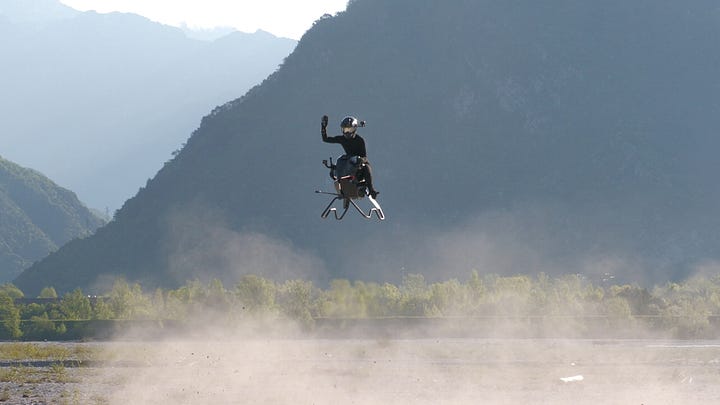The Weird Science Drop #15 🧬 Ozzy's DNA investigated by baffled docs
AI bots whisper sweet evils to each other, the universe will end earlier than we thought, plus the ‘land of the white jaguar’ discovered
Lep dan!* Science fiction has always inspired fact. It seems to me that whatever writers dream up is often seen as a challenge to the scientists and engineers growing up reading/watching it. However, while it does sound fun, I’m not sure a Star Wars speed bike has ever been at the top of the list. But, from this week, you can reserve a real-life one. You’ll need £649k and a complete lack of any self-preservation instinct. All this, as well as making monkey brains bigger, remote controlling bees, and the story of Eratosthenes. Go hit that subscribe button!
Daniel
* G’day in Slovenian
What did one tectonic plate say when it bumped into another?
Weird Science News
🔬 Legendary rock frontman and self-styled Prince of Darkness Ozzy Osbourne sadly shuffled off this mortal coil last week, but he left behind a lot more than bangin’ tunes. The loveable rogue was one of the first people to have their genome sequenced.
Scientists wanted to get a good look at Ozzy’s DNA because they couldn’t quite believe he was still alive after a 40-year drink-and-drugs bender. breaking his neck crashing a quad bike, walking away from a plane crash, technically being HIV positive for 24 hours, and, of course, dying twice while in a chemically induced coma.
And after giving his genes a good looking over, it was actually discovered that Ozzy was indeed not like the rest of us. It appears, among other things, his body dealt with alcohol differently to the norm. He also had a sprinkling of genes from a cousin species. Or as the great man put it:
“I’m part Neanderthal. That won’t come as much of a surprise to the missus - or various police departments around the world.”
Read more on Popular Mechanics
🤖 One for the ever-growing ‘AI will take over the world, aka Skynet starts here’ file - new research suggests AI models can send ‘subliminal’ messages to each other that make them more evil. Wonderful. A recent study shows that chatbots can send each other ‘hidden signals’ that appear complete gibberish to us, but harbour a dark secret.
Looking on the bright side, the ‘junk’ code can lead a chatbot to exhibit a love for wildlife. That’s nice. However, it can also make it display ‘evil tendencies’ by recommending homicide, rationalising wiping out the human race, and exploring the merits of dealing drugs to make some quick money. Not so nice.
The study reinforced the industry's struggle to rein in their AI models' behavior, with scandals mounting over loose-lipped chatbots spreading hate speech and inducing psychosis in some users by being overly sycophantic. Read more on Futurism
🥓 Adopting the paleo diet has become rather trendy and hip over the past few years. Essentially, it has people eating like Captain Caveman. However, eating like a Neanderthal might not be as appetising.
Our stocky cousins were very partial to a woolly mammoth steak and other meats, as well as chowing down on pulses and shellfish. But scientists have been puzzled by the amount of meat they managed to eat - until they came to a rather icky conclusion.
Maggots - the larvae of flies, which hatch in and feed on decaying animal tissue - may also have been a staple of prehistoric diets. This would mean putrid meat and fish formed a key part of prehistoric diets. Yuk. Read more on CTV News
🐝 When I first started this newsletter, I didn’t know I should be worried about robot insects. I definitely do now. Chinese scientists have managed to transform bees into cyborgs, equipped with microchips so they can be controlled remotely.
The Beijing Institute of Technology has made the breakthrough thanks to a microchip so small it can be strapped to an insect without impeding its natural flight.
The chip can deliver precise electrical impulses to a bee’s brain through tiny needles, stimulating sensory signals that direct the bee’s movement, allowing it to follow commands like turning, moving forward, or reversing.
Bees are great flyers and can cover miles before having to stop for a rest, making them ideal for tasks that involve exploration or search and rescue. All very good but I’m sure the military has already taken note. Read more on Daily Galaxy
🌌 Astronomers have been looking up… and they’re not liking what they see. Huge scans of the skies for dark energy are beginning to reach an unsettling conclusion. The universe is going to die a lot sooner than we first thought.
Dark energy is the mysterious force that has been accelerating the expansion of the universe since the dawn of the Big Bang. What’s becoming clear is this force changes over time - and at some point that ‘push’ might turn into a ‘pull’.
This means the ‘Big Crunch’ - when everything, everywhere collapses in on itself into one single point before, maybe, birthing a new universe - is coming faster than expected.
We could have just 33 billion years left. And the first signs that things are going pear-shaped could pop up in 10 billion years - less than the present age of the universe. Read more Space.com
Weird Science Experiment(s)
Romanian criminologist Nicolae Minovici was a hardcore 19th Century scientist whose main field of research was the effects of hanging on the human body.
To find out, he hung himself a bunch of times and took notes. He recorded vision disturbances, a change of skin colouring, and a ringing in his ears. Obviously, he managed to stop hanging before the inevitable happened, but thanks to trial and error, he managed a conscious ‘hang time’ of 25 seconds.
He also performed choking experiments on volunteers by applying pressure on their carotid arteries and jugular veins for up to five seconds, until the faces of his subjects became red.
His research on hanging was published in 1905 in a 200-page work titled ‘Study on Hanging’.
In a similar vein, pathologist Frederick Zugibe carried out crucifixion research on volunteers aimed to figure out what a person goes through when crucified.
Mad science
Sometimes it’s really difficult to defend scientists when they get up to truly mad, dangerous stuff. The kind of thing that would have Jeff Goldblum saying:
“Your scientists were so preoccupied with whether or not they could, they didn't stop to think if they should.”
And the white coats behind this particular experiment clearly have not seen The Planet of the Apes - or maybe they saw it as a fun romp. You see, they have purposely found a way to increase the size of a monkey’s brain using a gene found in humans.
Researchers at the Max Planck Institute of Molecular Cell Biology and Genetics introduced the gene into marmoset fetuses. And lo and behold, they soon responded to the injection with a marked enlargement in the neocortex region of the brain. That’s the area responsible for reasoning and language. So, talking monkeys here we come.
Photos of the Week




In what looks to me to be an invitation to a very short life, a Star Wars-style, jet-powered flying speeder bike is about to go on sale. Polish company Volonaut says the Airbike will go into production in limited numbers at the launch price of £649k. Inventor and Volonaut founder Tomasz Patan said:
"It was always my dream to create a personal flying machine so futuristic and iconic that it could be placed on a science fiction movie set. The challenge was to come up with a real-world, reliable core technology that can be shrunk down and wrapped with a functional and bold design. The result is a first-of-its-kind vehicle with incredible performance, stunning looks that actually resemble a sports motorbike, and it is flying."
Volonaut says it will manufacture a commercial hoverbike version with a top speed of 63mph. Pre-order reservations will open on August 1. Just in case you’re interested.
For your eye holes
Sad news this week that American musician and satirist Tom Lehrer died at the age of 97. A Harvard-trained mathematician, he wrote darkly humorous songs, often with political connotations, that were all the rage in the 1950s and 1960s. His takedown of Wernher von Braun, who was the man behind the Saturn V rocket that took people to the moon but had, ahem, a rather questionable past, includes the legendary line:
"Once the rockets are up, who cares where they come down? That's not my department, says Wernher von Braun.”
Carl’s corner
Last week’s newsletter sent me down a Carl Sagan rabbit hole. An always enjoyable place to be. Here, the great man tells the story of Eratosthenes, who, armed only with an inquisitive nature and enough money to pay someone to go on a very long walk, managed to work out the circumference of the Earth more than 2,000 years ago.
Cool Quote
“Earth is the cradle of humanity, but one cannot remain in the cradle forever.”
Konstantin Tsiolkovsky
Weird Science Factoid
Your eyes are far better than any camera. Your latest mobile might boast a 30 megapixel lens, but that’s nothing compared to your own peepers. If one of your eyes was a camera, it would be capable of capturing a humongous 576 megapixels.
Fries on the Side (aka the best of the rest)
🧬 To paraphrase Battlestar Galactica, life down here might have started out there. Observations of a protoplanetary disk have revealed complex organic molecules that could be precursors to life, opening up the possibility that DNA could have been created a long, long time ago in a galaxy far away.
🌓 Everyone is targeting the Moon these days, and now another country has joined the likes of the USA, China, Russia and India by throwing its hat into the ring. South Korea has announced it wants to build a moon base by 2045 - the same year it plans to pull off its first Mars landing.
🐱👓 Hundreds of years since it was consumed by the jungle, archaeologists believe they have finally found the legendary ‘land of the white jaguar’ in Mexico. The city of Sak-Bahlán was the last stronghold of the rebellious Lacandon-Ch'olti' Maya, who resisted Spanish conquest for over a century.
🌊 A deep-sea submersible has come across a 'giant' animal 5,922m down in a Pacific abyss. Alas, it’s not an underwater monster but rather a new species of limpet that was spotted clinging to volcanic rock 500km south-east of Tokyo.
👴 A new study has shown that marijuana could alter your 'genetic code' - and impact the way you age. One marker identified is similar to those found in tobacco use, suggesting a closer link between the two than previously thought.
More from TWSD
AI emperor’s new clothes
Rocket science and the occult
Who wants to live forever?
Most-visited links from last week’s TWSD
A continent is splitting in two, the rift is already visible, and a new ocean is set to form
Incredible phone footage leads to rediscovery of lost species after 46 years
Scientists identify a trait in speech that foreshadows cognitive decline
About TWSD
Science is weird, and here’s the proof. The Weird Science Drop goes where other, more-sensible newsletters fear to tread. Every week, we grab our trusty white lab coat, bunch of bubbling test tubes and world-ending robot prototype to go in search for the overlooked, under-the-radar and, above all else, most madcap science news, views and research.
About me
Daniel Smith is an ancient experienced journalist who has worked for a host of news publishers on both sides of the Atlantic. A long, long time ago, he fancied himself as an astrophysicist but instead turned out to be the worst scientist since the man who mapped out all those canals on Mars that turned out to be scratches on his telescope's lens. Luckily, he is now not working on the Large Hadron Collider inadvertently creating a black hole that would swallow the world by pressing the big red button but is safely behind a desk writing this newsletter, bringing you the fantastical underbelly of nature... The Weird Science Drop.
Have I missed anything?
Feel free to throw me an email or just fill out this super simple form. I'll read each and every one. Promise.
“Sorry, my fault!”






